THREE CREATURES IN MY BATHROOM
Sometimes I don't need to go far to find something interesting to observe through the macro lens. An extremely short walk from my room to the bathroom at the end of the hallway was more than enough last night.
In this post, you'll see three interesting species I encountered there. This is the first one. It looks like a moth but it's actually a fly. A small fly from the Psychodidae family. Clogmia albipunctata, the fly shown in this photograph, is commonly known as the bathroom moth midge, bathroom moth fly, or drain fly.
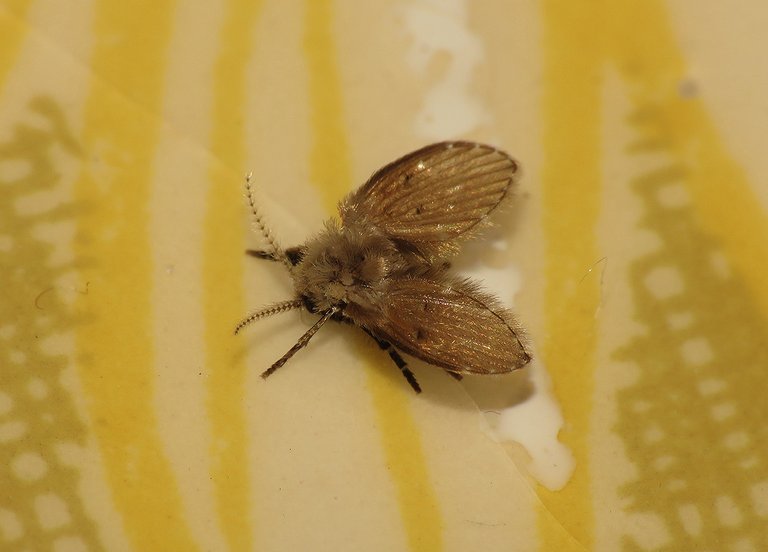
The adults can sustain themselves by drinking water, and not much else. If there is a chance they will consume nectar or any kind of sugary liquid found in or around human habitations. As adults, they live only about 12 days and spend most of their short life perched on walls.
The larvae live in aquatic environments, feeding on all kinds of decaying organic matter. It takes about 18 days for the larva to turn into a pupa, which after 5 days, develops into an adult. They often infest the drains of bathrooms, because those drains suit their lifestyle perfectly.
Today, early in the morning, while preparing the photographs for this post, I felt inspired to take the insects and make some artsy stuff with them in Photoshop.
In this triptych, you can see some Clogmia albipunctata variations.
Clogmia albipunctata is a very small insect but compared to the creature shown in the following photograph ...
... it looks like a giant. This is the Psyllipsocus ramburii, a barklouse from the Psyllipsocidae family. This minuscule insect is polymorphic. Brachypterous (which means with reduced, non - functional wings), pale, almost blind forms occur in drains and caves, and winged or brachypterous, pigmented forms with larger eyes can be seen in houses, gardens, and various open spaces. In the following triptych ...
... you can see the form with well-developed, very functional wings. These three photographs were taken three or four months ago, on the roses in my yard.
According to some Internet sources, wing development in this species appears to be affected by population density and temperature conditions.
This simple Photoshop edit gives a bit of mystery to the scene. This was my first encounter with brachypterous Psyllipsocus ramburii. I probably never noticed it before because is so extremely small. Last night, I was photographing another, still very small but a much bigger insect, when this barklouse jumped into the scene, right in front of my macro lens. I'm pretty sure that I wouldn't notice it with the naked eye. In the following photograph, you'll see the bigger insect mentioned before.

This is the Lepisma saccharinum, a very common bathroom creature commonly known as the silverfish.
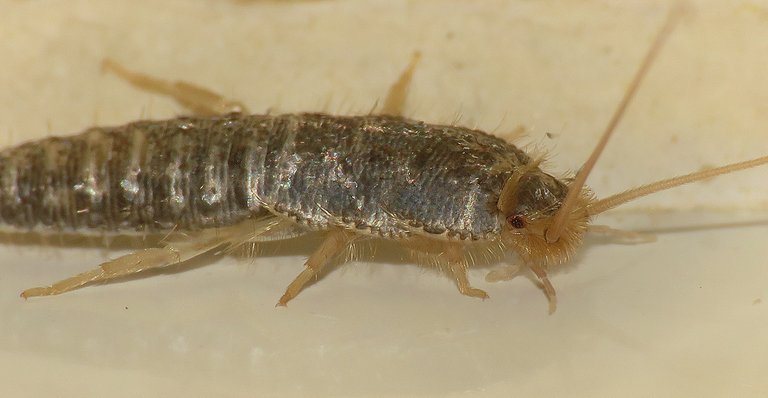
Here you can take a better, more up-close look at its cute face. 😀

In this simple monochrome edit with an invert option, the silverfish has a slightly Kafkian, unpleasant look.
Lepisma saccharinum is a primitive, wingless insect in the order Zygentoma.
The predecessors of silverfish, along with those of jumping bristletails, are considered the earliest and most primitive insects. They evolved at the latest in mid-Devonian and possibly as early as late Silurian more than 400 million years ago.

These are very resilient, highly adaptable animals that can thrive on a wide variety of food. Thanks to the cellulase produced by their midgut, they are able to digest cellulose without the help of bacteria, fungi, or protozoa. Silverfish consume matter that contains polysaccharides, such as starches and dextrin in adhesives. These include book bindings, carpet, clothing, coffee, dandruff, glue, hair, some paints, paper, photos, plaster, and sugar. They will damage wallpaper in order to consume the paste. Lepisma saccharinum can also cause damage to tapestries. Furthermore, these insects may eat cotton, dead insects, linen, silk, leftover crumbs, or their own molted exoskeleton. During the famine, a silverfish may even consume leather and synthetic fabrics. Silverfish can live for a year or more without eating if water is available.
The following links will take you to the sites with more information about the protagonists of this post. I found some stuff about them there.
https://en.wikipedia.org/wiki/Clogmia_albipunctata
https://anic.csiro.au/insectfamilies/biota_details.aspx?OrderID=42512&BiotaID=43654&PageID=families
https://en.wikipedia.org/wiki/Psyllipsocus_ramburii
https://bugguide.net/node/view/1410370
https://en.wikipedia.org/wiki/Silverfish
AND THAT'S IT. HOPE YOU ENJOYED THIS BATHROOM SAFARI. AS ALWAYS HERE ON HIVE, THE PHOTOGRAPHS ARE MY WORK.



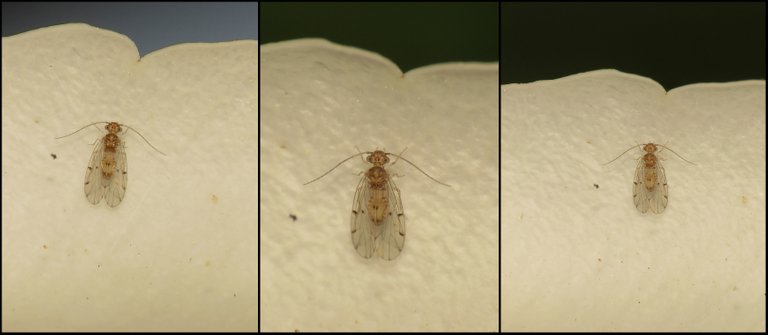
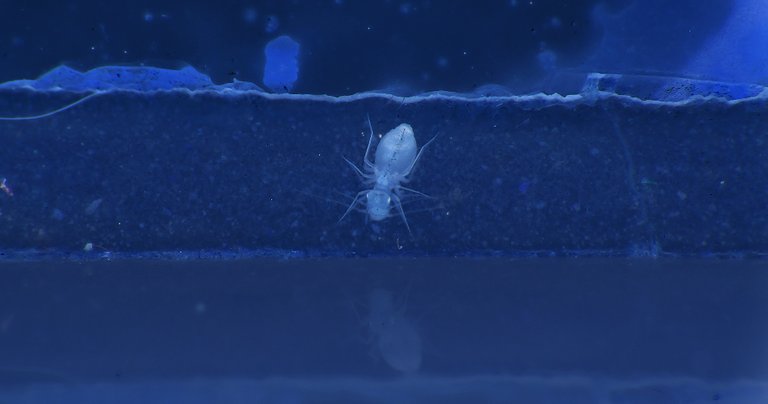
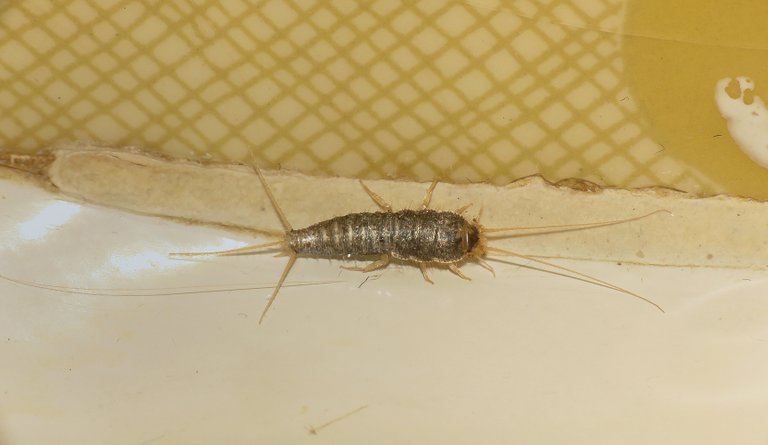
This is a quality content @borjan
#Hive on
very good post, friend, I really like the butterfly
The first fly looks indeed very moth like. Cute creature. The other two not that much hahaha 🤣
Great captures, love the different edits.
Sorry for being quite lately… still on holidays.
Have a great new week @borjan 👋🏻😊
Thanks. 😃 Have a great time on holiday.
You are welcome @borjan 😊
Thank you so much, will do 😎 enjoy your week!
Congratulations @borjan! You have completed the following achievement on the Hive blockchain and have been rewarded with new badge(s):
You can view your badges on your board and compare yourself to others in the Ranking
If you no longer want to receive notifications, reply to this comment with the word
STOPCheck out the last post from @hivebuzz:
The skin lice you show makes me feel a little ticklish, even though in my area there are probably a lot
Congratulations, your post has been upvoted by @dsc-r2cornell, which is the curating account for @R2cornell's Discord Community.
I remember seeing such little creatures in bathroom in summer and those time my son always called for help as was scared seeing them. It is funny that even through such creatures are so tiny we automatically will be scared.
Very nice compilation of photos @borjan. These small flies of the Psychodidae family I would say that they are the most common insects in bathrooms, their larvae can always be seen by the drains or cracks that there are both on the floor and on the walls of the shower, in these places they find all the food they need for their development, as you mention in your post. Greetings my friend.
Wow! The silverfish must surely come from Neptune a long time ago! They eat everything! Like a vacuum!
😀
Wow😂. The silverfishes are resilient, maybe even more than roaches. What a coincidence that I just saw the bathroom moth fly a few minutes ago😂
Very interesting info about these tiny critters. I know I have silverfish here, with 5000+ books it would be a miracle not to.